The "secret" Ofcom plan for Freeview HDTV: DVB-T2
 Brian Butterworth published on UK Free TV
Brian Butterworth published on UK Free TV Ofcom has a plan (found here) for bringing HDTV to 98.5% of the UK. It involves:
- Reducing the bit-rate of current SD services with associated picture quality degradation
- Reorganising channels between the Multiplexes, for example by moving some non-PSB services to the commercial Multiplexes
- Switching transmitters from DVB-T to DVB-T2 Phase 1
The current situation
In the UK, digital television though an aerial is provided using six transmission multiplexes that broadcast using a standard called DVB-T. Two of these multiplexes operate in one mode - 64QAM and the other four in 16QAM mode. The former delivers more data - 24Mb/s compared to 16Mb/s, but is more susceptible to interference. The total capacity is 120Mb/s for all six:
As each region switches over, the multiplexes will be all switched to 64QAM mode - as the transmission power can be increased to compensate. This creates 24Mb/s of additional capacity:
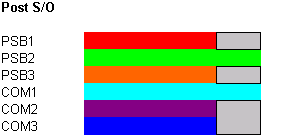
Ofcom propose that the non-PSB channels on multiplex PSB2 be moved to the capacity created on the COM2 and COM3 multiplex. These can include ITV2, 3 & 4, E4, More 4. This will result in this configuration:
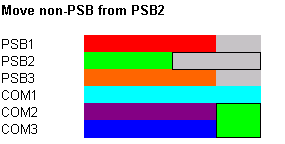
Now Ofcom propose that the BBC's capacity on PSB3 be moved to PSB2, like this:
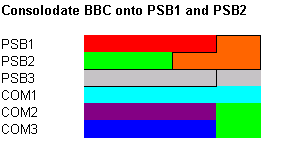
Now Ofcom reclaims 7Mb/s from the BBC, making this allocation:
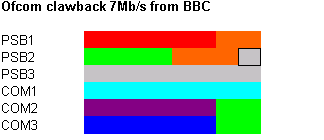
To provide universal coverage for five (or S4C or TeleG), some capacity is reallocated to PSB2 from COM1. This results in:
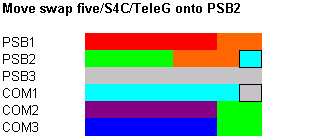
Now, as COM3 is now clear, it is repurposed for DVB-T2 transmission:
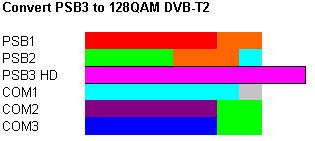
DVB-T2 is a new standard that uses 256QAM transmission mode combined with a new error correction protocol which delivers 30Mb/s, or about 25% more than 64QAM mode.
Also, all the transmissions will be in MPEG-4 (part 10) which offers better compression for standard resolution channels as well as high definition.
So, from 2009 the plan is:
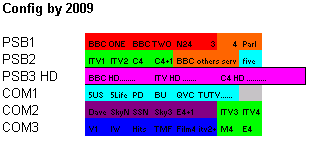
And by 2017 the rest of the multiplexes have transferred to DVB-T2
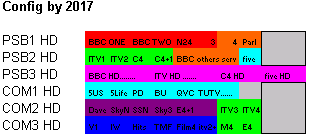
Is this a good plan?
This plan will deliver three at launch rising to four full-time HDTV services to every home in the country as switchover happens, with reasonable bandwidth for each service.However, this will be at the cost to those 8.5% of the population of some channels, such as ITV3, 4, More4 and E4 which they may have been expecting after switchover. DVB-T2 is a draft standard and is not yet beyond the first draft stage.
Regional switchovers are due to start properly in November 2008; it is unlikely that DVB-T2 receivers could be available by then, as the standard is not yet defined.
Some multiplex owners may have been expecting to benefit from the additional capacity created at switchover for their own services.
Also, the BBC has 7Mb/s taken from it for services it is already running, which using statistical multiplexing on BBC One will not compensate for.
For most people the DVB-T2 transmissions should not require a new aerial, but only those wanting the HDTV transmissions would need to get one.
In addition, most current MPEG4 services use more than the 10Mb/s allocated to the DVB-T system, such as on digital satellite where the BBC service is 16Mb/s, Sky Sports 1 HD is 18Mb/s, Sky Box Office HD is 19.5Mb/s and Discovery 16.4Mb/s. However, increasing computing power and technological advancement increase the compression ratio over time, perhaps supplying good quality HDTV at just 10Mb/s will be possible, as MPEG-2 compression ratios have improved over time.
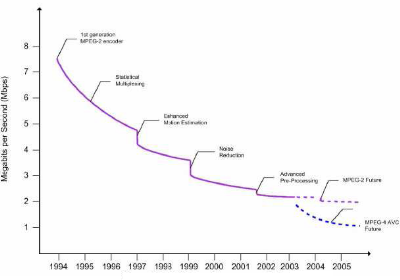

The DVB-T2 specification requirements
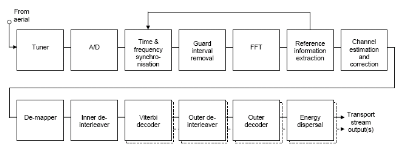
- The DVB-T2 specification shall be designed for stationary reception. However, it shall be possible to design DVB-T2 networks for all three receiving conditions, fixed, portable and mobile.
- Transmissions using the DVB-T2 specification shall meet the interference levels and spectrum mask requirements as defined by GE06 and not cause more interference than DVB-T would do.
- The DVB-T2 specification should target the maximum increase in net payload capacity over DVB-T with similar or better robustness than DVB-T under similar conditions.
- The DVB-T2 specification shall provide a minimum increase in net payload capacity of 30% greater than DVB-T for any given channel profile under similar conditions.
- The characteristics of the DVB-T2 specification shall not impair the ability to perform, or efficiency of, statistical multiplexing of DTV Services.
- The DVB-T2 specification should offer improved robustness against interference from other transmitters, compared to DVB-T, potentially improving frequency reuse.
- The DVB-T2 specification shall offer a choice of various robustness and protection levels to be applied equally on all data of a transport stream carried by a DVB-T2 signal in a particular channel.
- The DVB-T2 specification should offer a choice of various robustness and protection levels for each service separately, within a transport stream carried by a DVB-T2 signal in a particular channel. When more than one transport stream is carried by a DVB-T2 signal in a particular channel the DVB-T2 specification should offer a choice of various robustness and protection levels for each transport stream separately.
- The DVB-T2 specification shall provide a quality of service across the whole channel that approximates to no more than one corrupted event (to any audio, video or data services) per hour for HDTV and SDTV services.
- Impulsive noise performance of DVB-T2 shall be no worse than the DVB-T performance and should be substantially improved from that of DVB-T.
- The DVB-T2 specification shall enable changes in modulation mode to be detected automatically within 0,5s. However, the receiver may not be capable of performing seamless changeover.
- The DVB-T2 specification shall not introduce any more than 0,3s of additional delay in receiver channel changing and service selection times compared to DVB-T.
- The DVB-T2 specification shall be able to provide at least the minimum specified increase in payload capacity over DVB-T using existing transmitter sites and masts broadcasting to existing DVB-T domestic antenna and cable installations.
- The DVB-T2 specification should be designed to allow lower cost transmitters (in terms of both capital and operational costs) than currently for DVB-T (for a given output power).
- The DVB-T2 specification should enable larger scale SFNs than currently possible with DVB-T. The maximum distance between adjacent transmitters in the same SFN should be at least 30% larger than that offered by a comparable DVB-T 8k mode for the same level of self-interference.
- The DVB-T2 specification should enable the development of cheap and regulationcompliant home gap fillers to ease indoor coverage, for fixed, portable and mobile services.
- The DVB-T2 specification shall provide for local, regional and national coverage areas in an economical way (i.e. optimising infrastructure costs and spectrum usage including SFN and/or MFN techniques) whilst also meeting spectrum management conditions and constraints as defined within the relevant international treaties and other agreements.
- Any changes to the Service Information delivery caused by DVB-T2 specification shall be incorporated in the common DVB SI specifications.
- The DVB-T2 specification shall support direct carriage of MPEG2 transport streams and shall be capable of carrying all DVB transports including MPEG2 and GSE.
- The DVB-T2 specification shall support the carriage of multiple DVB transports simultaneously on a single channel.
- The DVB-T2 specified signal shall be able to be received using existing DVB-T domestic antenna and cable installations.
Help with High Definition?
| Whenever i watch moving sport especially football I experience much poorer pictu | 1 |
In this section
Sunday, 25 November 2012
M
michael 10:39 PM
Brian : will any of the current HD receivers
not be compatible with the new DVB/T2 standard?
The document implies that the cunning plan is to "encourage" consumers to invest in new equipment so as to receive the interim services and later the all DVB/T2. Whether or not 700MHz is later cleared, consumers should be informed NOW which equipment will become redundant in a few years time. Some will find repeated landfill-and-replace unduly expensiv - and confusing.
| link to this comment |
Tuesday, 11 December 2012
michael : There are no "official" HD receivers in the UK that are not DVB-T2.
Sets marked "HD Ready" or similar do not have HD tuners.
| link to this comment |